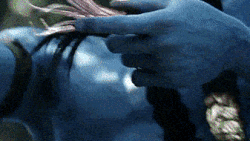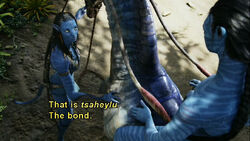
3D Version: red/cyan, cross-eyedNeytiri bonding with Seze
Tsaheylu is a Na'vi word meaning "bond" or neural connection. This describes the physical process by which Pandoran flora and fauna mentally connect to one another by the use of their queues.
Uses[]

Jake Sully performs tsaheylu with Pale
Tsaheylu has several different uses to different creatures, but primarily, it allows two beings to mentally connect and share information with one another. This information can be verbal communication, such as when a Na'vi issues commands to a banshee or direhorse to direct it without the use of reins, memories, and even sensory data. When two creatures are bonded, they gain access to each other's physical senses; this means they will feel the pain of whatever they are bonded to, among other things. The slinger makes use of this ability greatly, as its head and body are two separate entities connected by their queues, and the body does not possess eyes, meaning it cannot see when its head is disconnected and must navigate with sound.
Certain Pandoran florae can also perform tsaheylu with other creatures and plant life; this connection builds the foundations of the Pandoran neural network. This network can be accessed by the Na'vi and presumably other life forms at areas like the Tree of Souls and Tree of Voices; when a Na'vi connects with the network to commune with Eywa, they can upload their own memories and consciousness to the network, and even communicate directly with the spirits of the deceased.[1][2]
Here is a list of the possible uses:
- Animal taming and riding: Taming and riding creatures by use of tsaheylu is especially important to the Na'vi, wherein successfully bonding with and learning to ride direhorses, banshees, and other creatures is part of certain rites of passage into adulthood, including Iknimaya.
- Mating: The Na'vi also bond with each other when they mate to create a profound, lifelong spiritual bond with one another. It should be noted that tsaheylu is not considered erotic outside of the context of mating, nor is the queue part of a creature's genitalia.
- Mother's bonding: Directly after birth, newborn Na'vi perform their first instance of tsaheylu with their mother to form a strong emotional bond and with her.
- Tree of Souls communion: After the mother's bonding, they are brought to the Tree of Souls to connect to Eywa and the Pandoran collective consciousness for the first time.
- Tree of Voices listening: Na'vi can connect to the Tree of Voices to listen to the memories and "voices" of their deceased ancestors.
- Spirit Tree vision: The Spirit Tree has the ability to let the Na'vi encounter visions within the Pandoran neural network and thus Eywa.
- Memory access: In Avatar: Frontiers of Pandora, it is revealed that the Na'vi can connect their queues and access each other's memories. In Avatar: The Way of Water, Lo'ak is able to access Payakan's memories, suggesting it is also possible with tulkun although it is unclear if it can be done with other animals.
A final ability appears to be exclusive to Kiri; she is seen linking with a daisy anemone to control it.
Trivia[]

"Tsaheylu" spelling confirmed in DVD subtitles
- The correct spelling of this word was inconsistent. In all official written sources, it was spelled tsahaylu prior to the DVD/Blu-ray release. Due to the pronunciation that is constantly used in the Avatar film, the correct transcription should be tsaheylu, because the -ay- sound coincides with the sound found in English words like eye, whereas the -ey- sound is present in words like they.[3] This was confirmed by the DVD subtitles, where the tsaheylu spelling is used. Furthermore, the inventor of the Na'vi language, Paul Frommer, mentioned tsaheyl si as an expression for to bond with in an interview.[4]
- Before Paul Frommer was tasked with the development of a language for the Na'vi, James Cameron used shahaylu as the word for the bond as reflected by the script.
See Also[]
References[]
| Na'vi culture | |
|---|---|
| Clans | |
| Armor |
'Awvea Tsamsiyu • Battle Band • Eyktan • Helmet • Karyu • Leggings • Nawm • Nawma Ni'awve • Nawma Taronyu • Nawma Tsamsiyu • Taronyu • Tirea • Tsteu
|
| Clothing | |
| Culinary |
Basket • Butchering Tool • Cooking Pot • Fire Pit • Fire Pit Tools • Fish Yoke • Food Wrap • Ground Rack • Leaf Plate • Na'vi Diet • Water Carrier
|
| Music | |
| Other |
Eywa • Mountain Banshee • Octal Arithmetic • Toruk Makto • Hometree • Tree of Souls • Direhorse • Three Laws of Eywa • Iknimaya • Songcord • Tsahìk • Clan Leader • Na'vi Language • Mating • Loom • Hammock • Na'vi Dance Costume • Great Hunt • Seeing
|